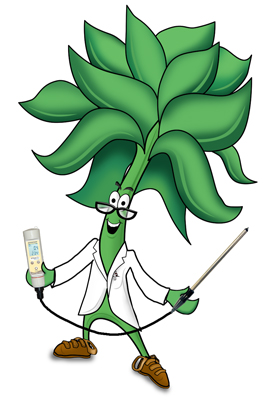Monitoring Salinity
June 13, 2014 09:35 AM

Monitoring Salinity
When people think of the relationship between salts and crops, the impression is that salt is harmful to plant growth. However, it must be remembered that whenever we add fertilizer, we are adding salt to the soil. So, when soil salinity is measured, it may be a case of too much or too little. If salinity is too high, the roots cannot bring in water. If salinity is too low, the plants may be starved for nutrients. This is especially critical for indoor operations that use growth media that has little or no natural fertility.
For day to day measurements, it is not practical to actually measure the amount of salt in irrigation  water or the soil. Fortunately, electrical conductivity (EC) can be used as a proxy for salt content. EC is a measure of how well an aqueous solution conducts electricity. It is influenced by the salt concentration and the temperature. The most commonly used units of measurement for EC are mS/cm, μS/cm, and dS/m, where S stands for Siemens. Because of the impact of temperature, most commercial EC meters automatically compensate their output to account for temperature differences between samples. Some meters will output TDS which stands for Total Dissolved Solids (or Salts). TDS is computed directly from EC using a conversion factor based on the dominant salts present in the sample. A typical conversion would be 1 mS/cm = 640 mg/L.
water or the soil. Fortunately, electrical conductivity (EC) can be used as a proxy for salt content. EC is a measure of how well an aqueous solution conducts electricity. It is influenced by the salt concentration and the temperature. The most commonly used units of measurement for EC are mS/cm, μS/cm, and dS/m, where S stands for Siemens. Because of the impact of temperature, most commercial EC meters automatically compensate their output to account for temperature differences between samples. Some meters will output TDS which stands for Total Dissolved Solids (or Salts). TDS is computed directly from EC using a conversion factor based on the dominant salts present in the sample. A typical conversion would be 1 mS/cm = 640 mg/L.
Most soil labs will report the EC from a saturated media extract (SME). The soil is wetted to saturation such that the soil glistens. A vacuum pump is then used to extract a liquid sample for measurement. A similar, but less sophisticated method is the Pour-Through technique. The soil is wetted in a similar way compared to an SME. But, instead of using a vacuum, a small amount of water is added to the top of the container to force a sample out of the bottom. Soil dilutions are an easy way to create a sample for a portable EC meter. The most common dilutions are 1 part soil to 2 parts water or 1 part soil to 5 parts water. Obviously, the interpretation of the EC measurement is dependent on how the sample was prepared.
Taking an EC measurement is simply a function of immersing two electrodes in the sample, applying a voltage and measuring the response. This is then converted to conductivity. All EC meters can take measurements in water or soil slurries. There are also meters that have the electrodes configured at the tip of a rugged probe that can be inserted directly into the soil. These probes are useful for sampling directly through a soil profile or for taking near surface measurements in a greenhouse plug tray.
Tracking salinity is an essential facet of any nutrient management program. Portable EC meters / probes are a convenient and affordable way to ensure you maintain a healthy root zone.
All the best,

Related Links:
FieldScout Direct Soil EC Meter
FieldScout EC 110 Meter
LAQUA Twin EC Meter
WaterScout SMEC Soil Moisture/Temperature/EC Sensor
Back